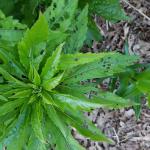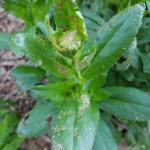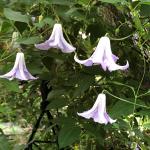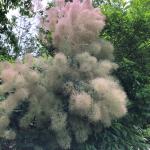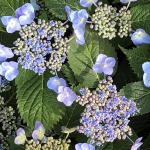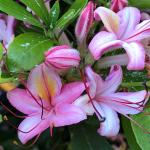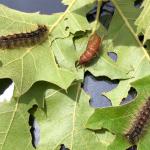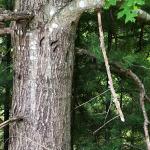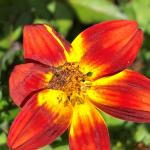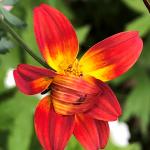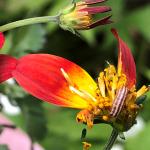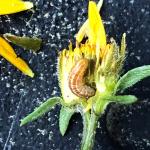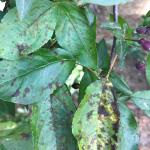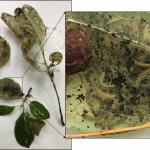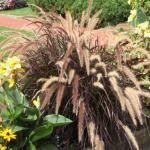UMass Extension's Landscape Message is an educational newsletter intended to inform and guide Massachusetts Green Industry professionals in the management of our collective landscape. Detailed reports from scouts and Extension specialists on growing conditions, pest activity, and cultural practices for the management of woody ornamentals, trees, and turf are regular features. The following issue has been updated to provide timely management information and the latest regional news and environmental data.
Happy Independence Day! The Landscape Message will be updated bi-weekly July through September. The next message will be available on July 13. To receive immediate notification when the next Landscape Message update is posted, be sure to join our e-mail list.
To read individual sections of the message, click on the section headings below to expand the content:
Scouting Information by Region
Environmental Data
The following data was collected on or about June 27, 2018. Total accumulated growing degree days (GDD) represent the heating units above a 50° F baseline temperature collected via our instruments for the 2018 calendar year. This information is intended for use as a guide for monitoring the developmental stages of pests in your location and planning management strategies accordingly.
|
MA Region/Location |
GDD |
Soil Temp |
Precipitation |
Time/Date of Readings |
||
|
1-Week Gain |
2018 Total |
Sun |
Shade |
|||
|
Cape Cod |
98.5 |
645.5 |
69 |
64 |
0.37 |
3:00 PM 6/27 |
|
Southeast |
n/a |
654 |
76 |
66 |
0.28 |
5:30 PM 6/27 |
|
North Shore |
79.5 |
745 |
63 |
60 |
0.79 |
9:00 AM 6/27 |
|
East |
101 |
855 |
67 |
64 |
0.39 |
3:00 PM 6/27 |
|
Metro West |
97.5 |
762.5 |
62 |
60 |
2.98 |
5:15 AM 6/27 |
|
Central |
97 |
697 |
62 |
55 |
2.11 |
7:00 AM 6/27 |
|
Pioneer Valley |
106 |
851 |
72 |
54 |
0.61 |
12:00 PM 6/27 |
|
Berkshires |
101 |
797 |
68 |
60 |
1.18 |
8:30 AM 6/27 |
|
AVERAGE |
167 |
751 |
67 |
60 |
1.09 |
- |
|
n/a = information not available |
||||||
Drought conditions update: According to June 26 data shown on the map dated June 28 (accessed by using the link below), Massachusetts is experiencing level D0 - 'Abnormally Dry' - in all areas of the following counties: Berkshire, Franklin, Hampshire, Hampden, Worcester, Middlesex and Essex. The western half of Norfolk County is also rated D0. The northwestern fifth of Franklin County is D1 - 'Moderate Drought'.
http://droughtmonitor.unl.edu/CurrentMap/StateDroughtMonitor.aspx?MA
Phenology
| Indicator Plants - Stages of Flowering (BEGIN, BEGIN/FULL, FULL, FULL/END, END) | ||||||||
|---|---|---|---|---|---|---|---|---|
| PLANT NAME (Botanic/ Common) | CAPE | S.E. | N.S. | EAST | METRO W. | CENT. | P.V. | BERK. |
|
Tilia cordata (Littleleaf Linden) |
Begin |
* |
Begin/Full |
Begin |
Begin/Full |
Begin |
Full |
* |
|
Campsis radicans (Trumpet Vine) |
* |
* |
* |
* |
* |
Begin |
* |
* |
|
Koelreuteria paniculata (Goldenrain Tree) |
* |
* |
Begin |
* |
* |
* |
* |
* |
|
Hydrangea macrophylla (Bigleaf Hydrangea) |
Begin |
Begin |
* |
* |
Begin |
* |
* |
* |
|
Hydrangea arborescens (Smooth Hydrangea) |
* |
* |
* |
* |
Begin |
* |
* |
* |
|
Itea virginica (Virginia Sweetspire) |
Begin/Full |
Full |
Full |
Full |
* |
Full |
Begin |
Full |
|
Rhus typhina (Staghorn Sumac) |
* |
Begin |
Begin |
Full |
Begin |
Begin |
Begin |
Begin/Full |
|
Sambucus canadensis (American Elderberry) |
Begin/Full |
Full |
Full |
Full |
Full |
Full |
Full |
Full |
|
Ligustrum spp. (Privet) |
Full |
Full |
Full |
Full |
Full |
Begin |
Full |
Full |
|
Catalpa speciosa (Northern Catalpa) |
Full |
Full/End |
Full |
End |
Full |
Full |
Full/End |
Full/End |
| * = no activity to report/information not available | ||||||||
Regional Notes
Cape Cod Region (Barnstable)
General Conditions: The average temperature over the last week was 65°F with a high of 78°F on June 21 and a low of 48°F on June 26. In Barnstable, 0.37 inches of precipitation fell primarily on June 23. Some locations saw closer to 0.75-1.00 inch of precipitation. Prior to that precipitation, soil conditions were getting very dry. Topsoil moisture is short, subsoil moisture is adequate.
Pests/Problems: Insects observed over the last week include wooly elm aphid (Eriosoma americanum) on American Elm, cottony camellia scale (Pulvinaria floccifera) on American holly, azalea scale (Ericoccus azalea) on rhododendron, Lecanium scale on oak, native holly leafminer (Phytomyza ilicicola) on American holly, hibiscus sawfly (Atomacera decepta) on hardy hibiscus, columbine leafminer and columbine sawfly (Pristiphora rufipes) on columbine, turpentine beetle on pitch pine, four-lined plant bug (Poecilocapus lineatus) damage on shasta daisy and various other perennials, black vine weevil damage on Rhododendron, lacebug on azalea and andromeda. Viburnum leaf beetle damage can be seen but most have migrated to the ground to pupate. Diseases visible over the last week include bacterial leaf spot on Rudbeckia fulgida ‘Goldstrum’, cedar apple rust on crabapple, Exobasidium gall on azalea, Phytophthora root rot on catmint, black spot on rose, downy mildew on ornamental hops, daylily leaf streak on daylily and red thread on turf. Sycamores susceptible to sycamore anthracnose are finally pushing out healthy leaves. The following weeds are in bloom: black swallowwort (Cynanchum nigrum), multiflora rose (Rosa multiflora), red sorrel (Rumex acetosella), curly dock (Rumex crispus), black medic, (Medicago lupulina), white clover (Tricolium repens), annual fleabane (Erigeron annuus), prostrate spurge (Euphorbia maculata), common groundsel (Senecio vulagris) and hawkweed (Hieracium pretense). Rabbits are abundant. Black legged ticks (deer tick) nymphs are active so keep yourself protected with permethrin-treated shoes and clothing.
Southeast Region (Hanson)
General Conditions: The weather remains cool for June. It was 49 degrees the morning of June 26th and June 23rd was also cool (50s to low 60s and drizzly - a raw day). As far as rainfall, May and June have been very dry with only 6.20 inches of rain over the past 9 weeks. Hanson received 0.78 inches of rain over the past two weeks. Supplemental irrigation has been needed in many managed landscapes, conflicting with water bans in some towns. Un-irrigated plants, lawns and even weeds are showing signs of drought stress. Soils are dry, so continue to remind clients to water newly planted or transplanted plants and those plants defoliated by caterpillars. We are still waiting for a substantial rain to clear white pine pollen off the foliage of plants. Pruning plants at this time, usually results in sneezing and choking, due to the clouds of white pine pollen billowing up from the foliage.
The following plants are in bloom: Northern Catalpa, Stewartia pseudocamellia, Stewartia rostrata, Cornus kousa, Magnolia virginiana (sweetbay magnolia), Hypericum androsaemum ‘Mrs. Gladis Brabazon’, Weston hybrid summer azaleas, Hydrangea ‘Blue Billow’, Itea virginica, Spiraea spp., Rhododendron maximum, Kalmia, Indigofera spp., landscape roses, Rosa rugosa, Schizophragma hydrangeoides (Japanese Hydrangea vine), Hydrangea arborescens, mockorange, Ilex verticillata, Clematis spp., Lonicera sempervirens, Lonicera ‘John Clayton’, Lysimachia punctata, Campanula spp., Aruncus dioicus, early daylilies, Nepeta spp., Salvia spp., Oenothera spp., Geranium spp., Astilbe, Doronicum spp., Anemone canadensis, Persicaria polymorpha, Lamium, Nepeta spp., Dianthus spp., Corydalis lutea, Astrantia spp., and foxgloves. Hydrangea quercifolia, Rudbeckia ‘Herbstonne’, Deinanthe caerulea, Hosta spp. and Asclepias syriaca (common milkweed) are beginning bloom.
Clematis ‘Betty Corning’ (photo 1) is in bloom. This is a delightful clematis, especially when allowed to ‘scamper’ over shrubs, on a trellis, or a tree. It is fragrant and a Cary Award Winner: http://caryaward.towerhillbg.org/2017/10/31/clematis-betty-corning/
Hydrangea anomala petiolaris is ending bloom. Rhus typhina (staghorn sumac) has ended flowering and is beginning to show its red fruiting clusters. Cotinus obovatus (American smoketree) and Cotinus coggygria (European smokebush) continue to display their colorful “smoke” (photo 2). As noted above, Hydrangea ‘Blue Billow’ (photo 3) is in bloom at the Hanson, MA site. It is one of few Hydrangea macrophylla that will be in bloom at this site, along with H. ‘Lady-in-red’ and H. ‘Preziosa’. As mentioned a few weeks ago, this is the fourth year in a row in many areas that the overwintering stems of most Hydrangea macrophylla were winter-killed and/or bud-killed. Clients who are looking for hardier Hydrangea macrophylla may want to check out the more cold-hardy hybrids like Hydrangea macrophylla ‘Blue Billow’ or H. ‘Lady-in-red’ or the remontant (repeat-blooming) Hydrangea macrophylla which produce flowers on new wood. Weston hybrid summer flowering azaleas are great plants for early to mid-summer color. There is a range of cultivars that bloom in June, July and even August, with colorful and often fragrant flowers (photo 4: Azalea ‘Pink and Sweet’ – highly fragrant!)
Pests/Problems: Gypsy moth caterpillars are at 5th instar (male) and 6th instar are winding up feeding for the season and starting to pupate (photo 5). Overall, there are not many caterpillars to observe and some caterpillars are dying from disease (photo 6). Trees are looking great and in some areas oaks that were defoliated last year are showing little damage. Overall, the trees in many areas of Plymouth County look really good with no significant damage from gypsy moth caterpillars. Although there was not a huge display of dead and dying caterpillars from virus or the Entomophaga maimaiga fungus, it is likely that the cool wet weather we had in May might have contributed to some caterpillar deaths. Two weeks ago, I had noticed a dramatic drop in the amount of frass falling from the oak trees when the caterpillars were at 4th and 5th instars, and that reduction in frass continued; less frass usually means fewer caterpillars devouring foliage. In 2017, at the Hanson, MA site, several large oaks were defoliated along with a large Katsura and two Rutgers hybrid dogwoods. One of the large oaks never recovered and is now dead. This year, the remaining oaks at the Hanson, MA site, show some damage but are not defoliated and the Katsura and dogwood are clear of any damage. After pupating, gypsy moths will emerge. The large white-tan female moths cannot fly but will send out a pheromone to attract and mate with the brown male moths and produce the tan, fuzzy egg masses that will hatch next April 2019. (For a complete gypsy moth update, see the Insect section of this Landscape Message).
Caterpillars of the sunflower moth, (Homoeosoma electellum), were found in flowers and flower buds of Bidens ferulifolia. Sunflower moths lay eggs on the developing flower buds of plants in the Compositae (Asteraceae) family. The eggs hatch into small, brownish-dark grey caterpillars which destroy the buds and flowers, making them appear ‘rain-damaged’ and messy (photo 7). The caterpillar often seems to “pull” a petal, or petals, over the center of the flower (photo 8). If you notice this on Bidens, Echinacea, etc., gently pry the flower apart and look for the caterpillar feeding down at the base of flower (photos 9 & 10). Besides Bidens, monitor other composite plants like Echinacea, Helianthus, Rudbeckia, Heliopsis and marigolds.
Monitor for dogwood sawfly larvae on certain dogwood species like Cornus controversa, Cornus sericea and Cornus racemosa. Continue to monitor for Andromeda lacebug feeding on Pieris japonica. Also monitor Rhododendrons for Rhododendron lacebug and evergreen azaleas for azalea lacebug. Lacebugs are active late into the summer season and can cause serious damage to plants unless managed early. Sod webworm moths are active. At dusk, look for the small, tan moths as they fly low, zigzagging over turf as the females lay eggs which will hatch into sod webworm caterpillars that feed on turf species. https://ag.umass.edu/fact-sheets/sod-webworms-0 Hibiscus sawfly continues to feed on the foliage of untreated perennial Hibiscus.
The following insects remain active: four-lined plantbug, mosquitoes, deer ticks, dog ticks, European chafer beetles, Asiatic garden beetles, lacebugs on Japanese Andromeda (Pieris japonica), Rhododendron and azaleas, golden tortoise beetle, white pine sawyer beetle (an Asian longhorned beetle look-alike), hemlock woolly adelgid, elongate hemlock scale, cottony camellia scale on Meserve hollies and Taxus, Fletcher scale on Taxus, Taxus mealybug, earwigs, planthoppers, leafhoppers, stink bugs, aphids, lily leaf beetle (adults, eggs, larvae), slugs, snails and wasps. Beneficial insects also remain active. Remove the white, spore-covered Azalea leaf galls (Exobasidium vaccinii) from deciduous Azaleas and place them in the trash.
The following weeds are in full bloom: Japanese honeysuckle (Lonicera japonica - Massachusetts invasive plant), Achillea, grasses, fleabane, bouncing Bet, oxeye daisy and red and white clover. Multiflora rose is ending bloom. Continue to pull weeds, especially invasive weeds like: Oriental bittersweet, black swallowwort, multiflora rose, barberry, burning bush and autumn olive. For a list of Massachusetts invasive weedsclick here: https://www.mass.gov/files/documents/2016/08/tm/invasive-plant-list.pdf Several landscapers have reported seeing Lysimachia nummularia L. (creeping jenny or moneywort), a plant on the Massachusetts Invasive Plant List, available at garden centers. Deer are browsing perennials (hosta, phlox, etc.). Employing repellents, fencing, etc., to deter deer now, may help prevent considerable damage later in the season.
North Shore Region (Beverly)
General Conditions: The weather this reporting period was very pleasant for outdoor activities during the day and for sleeping at night. Most days had clear or overcast skies with day temperatures in the low to mid 70s and night temperatures in the mid 50s. The last several weeks have been dry, but a fast moving storm on the night of June 24th brought some much needed rain. Approximately 0.79 inches of rainfall was recorded at Long Hill, Beverly. Woody plants seen in bloom include: tall Stewartia (Stewartia monadelpha), longstalk holly (Ilex pedunculosa), Japanese tree lilac (Syringa reticulata), Peking tree lilac (Syringa pekinensis), Stewartia (Stewartia rostrata), Kousa dogwood (Cornus kousa), Lemoine Deutzia (Deutzia lemoinei), sweet azalea (Rhododendron arborescens), Virginia sweetspire (Itea virginica), magician Deutzia (Deutzia magicien), oakleaf Hydrangea ( Hydrangea quercifolia), Japanese Hydrangea vine (Schizophragma hydrangeoides) and mountain laurel (Kalmia latifolia). Herbaceous plants in bloom include: white Clematis (Clematis paniculata), Virginia rose (Rosa virginiana), garden roses (Rosa spp.), Baptisia (Baptisia australis), Nepeta (Nepeta spp.), geranium (Pelargonium spp.), Aruncus (Aruncus dioicus), Corydalis (Corydalis lutea), Allium (Allium spp.), water lily (Nymphaea odorata) and oxeye daisy (Leucanthemum vulgare).
Pests/Problems: Deer browsing continues to be observed in the landscape. Woodchucks are also causing damage on some garden plants. If you have problems with woodchucks in your garden, consider non-lethal control measures such as setting up a fence around the garden with a mesh size less than 2 X 2 inches. Blister galls continue to be observed on grape vine leaves. Continue to remove the galls to reduce the number of midges present. Weeds in the landscape continue to flourish. Take measures to control weeds before they set seed. Ticks and mosquitoes continue to be very active. Protect yourself with a repellent when working outdoors.
East Region (Boston)
General Conditions: We welcomed the summer solstice on June 21. Low temperatures were consistent over the last week, ranging from 51°F to 59°F, averaging 55°F. High temperatures ranged from 65°F to 83°F, averaging 76°F. We gained 101 GDDs over the last week, bringing the total to 855 GDDs for the year. Thunderstorms on the evening of the 24th into the 25th brought only 0.39 inches of precipitation. Dry soils received some moisture however, much more is needed. Supplemental watering of new transplants (this spring and last year) continues. Despite the lack of rain, the landscape remains lush. Many trees, shrubs, and herbaceous perennials continue to provide color to the landscape: Aralia californica (elk clover), Astilbe thunbergii var. congesta (Astilbe), Castanea mollissima (Chinese chestnut), Hydrangea quercifolia (oakleaf Hydrangea), Ilex pedunculosa (longstalk holly), Kniphofia uvaria (red-hot poker), Lilium spp. (true lilies), Nymphaea odorata (American white waterlily), Pterostyrax hispidus (epaulette tree), Rhododendron viscosum (swamp azalea), Rosa spp. (rose) cultivars ‘Betty Prior’, ‘Blaze’, ‘Bonica’, Coral drift®, ‘Dorothy Perkins’, ‘New Dawn’, Scarlet Meidiland® and many more, Stewartia pseudocamellia (Japanese Stewartia), S. sinensis (Chinese Stewartia), Tilia amurensis (Amur linden), T. henryana (Henry's lime) and T. platyphyllos (bigleaf linden). Morus alba (white mulberry) fruit is ripe.
Pests/Problems: The 0.39 inches of precipitation we received this week had minimal impact on soil conditions. Most soils remain dry. New plantings and drought intolerant species require supplemental irrigation. Landscape weeds are thriving and crabgrass is prevalent. Weeds/wildflowers in bloom this week include: Circaea lutetiana (enchanter's-nightshade), Geum canadense (white avens), and Prunella vulgaris (common selfheal). In natural wooded areas, Celastrus orbiculatus (Oriental bittersweet) and Toxicodendron radicans (eastern poison ivy) are running rampant. Rumex obtusifolius (bitter dock) is in seed and near maturity; now is the time to remove the seed heads before the seeds start dropping. Rhamnus spp. (buckthorn) has germinated in moist wetland areas. Seedlings are an inch in height at this time. Euphorbia maculata (spotted spurge) has germinated. Azalea bark scale (Eriococcus azalea) have been observed in their crawler stage. Remnants of rose leaf miner activity can be easily spotted as leaves exhibiting the damage are tan in color. Witchhazel blight, caused by the fungus Phyllosticta hamamelidis, is evident on witchhazel throughout the landscape as brown lesions on leaf margins.
Metro West (Acton)
General Conditions: The first week of summer brought with it hot, humid weather on the 24th, a fast moving thunder, lightning and rain event overnight and into the early hours on the 25th and more much needed rain on the 24th. For June, the monthly average precipitation is 3.93” and only 2.98” of rain has been recorded for this month so far. The landscape is lush and colorful with all that is in bloom. In some stage of bloom at this time are the following woody plants: Catalpa speciosa (Northern Catalpa), Clematis spp. (Clematis), Cornus kousa (Kousa dogwood), Hydrangea arborescens (smooth Hydrangea), H. quercifolia (oakleaf Hydrangea), Ligustrum spp. (Privet), Liriodendron tulipifera (tulip tree), Oxydendron arboreum (sourwood), Potentilla fruiticosa (Potentilla), Rhus typhina (staghorn sumac), Rosa rugosa (rose), R. 'Knockout' (the Knockout family of roses), Rosa spp. (rose), Sambucus Canadensis (Elderberry), Spirea japonica 'Alpina' (Daphne Spirea), Spirea spp. (bridal wreath), Stewartia psuedocamellia (Japanese Stewartia), Syringa reticulate (Japanese tree lilac)and Tilia cordata (littleleaf linden).
Contributing even more color and interest to the landscape are some flowering herbaceous plants including: Achillea millefoliumn (yarrow), Aruncus aethusifolius (dwarf goat's beard), A. dioicus (goat's beard), Asclepias syriaca (common milkweed), A. tuberosa (butterfly weed), Astilbe spp. (false Spirea), Campanula persicifolia (peach-leafed bell flower), C. takesimana ‘Elizabeth’ (bellflower), Chrysogonum virginianum (green and gold), Clematis recta 'Purpurea' (Clematis), Coreopsis spp. (tickseed), Dicentra eximia (fringed bleeding heart), Digitalis purpurea (foxglove), Filipendula spp. (meadow sweet), Gaillardia aristata (Indian blanket flower), Geranium cantabrigiense 'Biokovo' and 'Cambridge' (hardy cranesbill), G. macrorrhizum (bigroot Geranium), G. sanguineum (cranesbill Geranium), G. ‘Johnson’s Blue’ (cranesbill), Hemerocallis fulva (orange daylily), H. 'Stella D'Oro', (daylily), H. spp. (daylily), Heuchera spp. (coral bells), Lupinus 'Russell Woodfield Hybrids' (lupine), Leucanthemum spp. (shasta daisy), Lilium spp. (lily), Lychnis coronaria (rose campion), Nepeta spp. (ornamental catmint), Oenothera macrocarpa (Ozark sundrops), Paeonia spp. (peony), Penstemon digitalis 'Huskers Red' (beardtongue), Salvia nemerosa (Salvia), Sedum kamschaticum (Russian stonecrop), Silene latifolia (white campion), Stachys byzantina (lamb’s ear), Thermopsis caroliniana (Southern lupine), Thymus praecox (thyme), Tradescantia spp. (spiderwort) and Veronica spp. (speedwell).
Pests/Problems: 1.82” of rain was recorded over 3 days with 0.97” recorded on the 25th causing much erosion. Despite the recent rain, recorded precipitation is below average levels. The lack of any substantial rain is a concern for our trees and shrubs in the landscape especially compounded with any other stresses such as winter or gypsy moth caterpillars, hemlock woolly adelgid, snow and ice removal applications or previous years’ droughts. Signs of stress are apparent in the landscape including premature leaf drop on birches and apple scab on crabapples.
Central Region (Boylston)
General Conditions: Warm weather conditions persist, and while 2.11” of rain fell over the last week, we are still behind on rainfall for the month. Also the majority of the 2.11” of rain fell during an intense thunderstorm and a fair amount ran off thus did not have a chance to soak in. Trees, shrubs and vines in bloom include: Catalpa speciosa (northern Catalpa), Clematis 'Betty Corning' (Clematis), Cornus kousa (kousa dogwood), Hydrangea arborescens (smooth Hydrangea), H. quercifolia (oakleaf hydrangea), Ilex glabra (inkberry), Ilex verticillata (winterberry), Rhododendron, Rosa rugosa (beach rose), Sambucus canadensis (elderberry), Sambucus nigra 'Eva' (black lace elderberry), Spiraea japonica 'Nana' (dwarf Spiraea), Stewartia pseudocamellia (Japanese Stewartia), Syringa reticulata 'Copper Curls' (Japanese tree lilac) and Tilia cordata (littleleaf linden). Herbaceous perennials and bulbs blooming include: Achillea 'Coronation Gold' (yarrow), Achillea 'Paprika' (yarrow), A. dioicus (goat's beard), Asclepias syriaca (common milkweed), Callirhoe involucrata (purple prairie mallow), Geranium ‘Gerwat’ (Rozanne hardy geranium), Hemerocallis cvs. (daylilies), Heuchera spp. (coral bells), Iris ensata (Japanese iris), Leucanthemum x superbum 'Becky' (shasta daisy), Nepeta x faassenii (hybrid catmint), Penstemon 'Midnight Masquerade' (beardtongue), Phlox 'Minnie Pearl' (hybrid phlox), Salvia nemerosa (woodland sage), Sedum 'Angelina' (stonecrop), Stachys officinalis 'Hummelo' (betony), Thermopsis caroliniana (southern lupine), Triteleia laxa 'Koningin Fabiola' (starflower) and Veronica incana (speedwell).
Pests and diseases: Pine sawfly was noted, but not in large numbers. Gypsy moth caterpillars are beginning to pupate, but many are still actively feeding. With the recent rain, and more in the forecast, hopefully we will see more impact from the fungus Entomophaga aimaiga. Hibiscus sawfly damage on perennial hibiscus was noted. A few cabbage worm butterflies have been seen flitting about the cole crops.
Pioneer Valley Region (Amherst)
General Conditions: Conditions over this past week were generally ideal for being outdoors, with high temperatures in mid-70s to mid-80s and lows in the upper 50s. Humidity was mildly uncomfortable at times but was low overall during the past week. Day length is at its peak with over 15 hours between sunrise and sunset. Cool and cloudy weather predominated on Saturday 6/23 with very patchy, light rainfall. A large band of thunderstorms then moved through New England on Sunday, 6/24 but accumulations were minor to moderate for much of the Pioneer Valley. In Hampden and Hampshire Counties, total rainfall ranged from 0.4 – 0.7” while totals in Franklin County were higher, ranging from 0.8 to >1” in some locations. The rain and cooler temperatures, compared to mid-June, has helped some landscape plants and turf grasses. But, it’s been a long time since there was a widespread, soaking rainstorm in the valley and brown lawns are abundant at this time. Continue to irrigate newly transplanted trees and shrubs, especially as we enter the month of July. The long-term forecast calls for an extended period with high temperatures >90°F. If the forecast pans out, it will represent our first (and hopefully last) heat wave of the summer. Most trees and shrubs still appear lush but dieback symptoms are also abundant. Silver and red maple, crabapple, yew and oak are flushing additional growth at this time.
Pests/Problems: Crabapples and apples are shedding leaves due to apple scab infections (see photo below). However, many trees are still flushing new growth so they should withstand the premature leaf shedding. Early instars of the fall webworm (Hyphantria cunea) were discovered feeding on a North Star cherry (Prunus cerasus 'North Star'; see photo below). The fall webworm is native to North America and has a large host range on ornamental trees, shrubs and vegetable crops. Scout for skeletonized leaves with silken tents and large numbers of small caterpillars. Phyllosticta leaf blotch is present on large spring-flowering witchhazels. Significant blotching and leaf shedding is present in some cases. Symptoms of Dutch elm disease continue to appear on the landscape, even among resistant American elm cultivars. Yellow flagging in the canopy is not always present, scout for any wilting or dieback of canopy branches and remove the bark to observe the characteristic vascular staining. Damage from privet thrips is now visible. Feeding by this insect pest appears as flecking or stippling on the upper surface of the foliage. The thrips themselves are too small to observe in the field. Continue to prune and discard blighted stems and branches as they develop on deciduous hardwoods and conifers, especially for trees with thin bark, such as Japanese maple and dogwood. We are entering the time when annual mushrooms produced by Laetiporus (chicken of the wood) become visible at the base of infected hardwoods. Oaks are the most common host but the fungus can be found on a variety of other hardwoods. Mosquito populations seem to be down a bit from their peak a few weeks ago.
Berkshire Region (Great Barrington)
General Conditions: A much welcomed rain dropped 1.18 inches on the evening of June 24 and through to the morning of June 25. Prior to the rain it was not unusual to see some turfgrass browning. Temperatures through the period were close to the norm for late June. Woody and herbaceous plants which had showed some signs of drought stress seem to have recovered and landscapes are verdant. Late June has also brought a flush of colorful bloom in perennial flower borders. While many spring flowering trees and shrubs have completed their floral display for the year, a few continue in flower though clearly past their peak. Weigela and mock orange still cling to a few blossoms. Growth of turfgrass had slowed dramatically through much of June but has picked up the pace again and with significant rain expected on June 27 and 28, the frequency of mowing will also pick up. With the arrival of summer, it is advisable to maintain a high cutting height for turfgrass. Taller grass has the effect of shading the soil which reduces evaporation of soil moisture, keeps roots cool and encourages deep root development.
Pests/Problems: Plant disease pressures have remained low this monitoring period throughout the Berkshires. Some leaf spot is apparent on a few trees and shrubs but only cedar apple rust and apple scab are prominent. Black spot on roses is occurring but not to a great extent. Likewise, rose mosaic virus was spotted on a few roses but was limited. The most obvious symptom of rose mosaic virus is the appearance of yellow zigzag lines on the leaves.
Insects observed this week include imported willow leaf beetle adults and larvae, spruce spider mite and aphids on tulip tree (Liriodendron tulipifera). Sticky sap dripping from magnolias and sooty mold covered leaves are symptoms of feeding by magnolia scale, a common problem now on many magnolia species and cultivars. Some crawlers of euonymus scale could still be found though most have settled. Adult flies of boxwood leaf miner are no longer present, having completed their egg laying in the new foliage of boxwood. Shearing boxwood now will help reduce the amount of damage from the leaf miners later this summer. Ants have been particularly abundant this year. Likewise, deer tick, wasp and mosquito populations are high.
Regional Scouting Credits
- CAPE COD REGION - Russell Norton, Horticulture and Agriculture Educator with Cape Cod Cooperative Extension, reporting from Barnstable.
- SOUTHEAST REGION - Deborah Swanson, UMass Extension Horticulturist for Plymouth County - Retired, reporting from Hanson.
- NORTH SHORE REGION - Geoffrey Njue, Green Industry Specialist, UMass Extension, reporting from the Long Hill Reservation, Beverly.
- EAST REGION - Kit Ganshaw & Sue Pfeiffer, Horticulturists, reporting from the Arnold Arboretum, Jamaica Plain.
- METRO WEST REGION - Julie Coop, Forester, Massachusetts Department of Conservation & Recreation, reporting from Acton.
- CENTRAL REGION - Dawn Davies, Interim Horticulture Manager, reporting from Tower Hill Botanic Garden, Boylston.
- PIONEER VALLEY REGION - Nick Brazee, Plant Pathologist, UMass Extension Plant Diagnostic Lab, reporting from UMass Amherst.
- BERKSHIRE REGION - Ron Kujawski, Horticultural Consultant, reporting from Great Barrington.
Woody Ornamentals
Diseases
Recent pests and pathogens of interest seen in the UMass Plant Diagnostic Lab ( https://ag.umass.edu/services/plant-diagnostics-laboratory ):
Needle blight of eastern white pine (Pinus strobus) caused by the following fungi: Lecanosticta acicula (brown needle spot), Septorioides strobi, Bifusella linearis (Bifusella needle blight) and Hendersonia pinicola. Samples originated from six forest sites in Massachusetts and are part of a joint U.S. Forest Service and Mass. DCR study investigating white pine needle blight. Blighted and browning needles were collected from understory trees and seedlings. The brown needle spot pathogen, Lecanosticta, has been identified as one of the primary drivers of white pine needle blight throughout the northeast. Lecanosticta and Septorioides were present at 5/6 sites, co-occurring four times.
Foliar anthracnose, caused by Colletotrichum, of sand cherry (Prunus pumila) and Tulip poplar (Liriodendron tulipifera). The sand cherry is eight-years-old and has been present at the site for four years. In May of this year, the shrub exhibited blackening of new shoots and succulent leaves curled and died. The tulip poplar is approximately 30-years-old and also began showing symptoms in May. The majority of leaves have wilted and dropped from the canopy with only a few branches retaining undersized foliage. In both cases, marginal blight and spots and blotches were present. In addition, the fungus will attack the petiole, leading to wilt and death of the leaf when only portions of the leaf surface itself are diseased.
Botrytis blight, caused by Botrytis cinerea, of tree peony (Paeonia suffruticosa). Plant is 10-years old and has been present at the site for seven years. The site is mostly shaded and the plant receives compost tea once weekly. Botrytis thrives under humid conditions and is most prominent in the spring and fall. It causes a bud and blossom blight along with succulent shoot dieback. The fungus is common as a secondary colonizer of severely weakened trees and shrubs but is a primary problem for many flowering plants, especially rose.
Severe leaf spotting caused by cedar-apple rust (Gymnosporangium juniperi-virginianae) on Colonnade apple (Malus domestica). This columnar cultivar is touted for small yards and urban environments where space is minimal. This tree has been present at the site for over 20 years and resides in full sun with sandy soils and supplemental irrigation. Yellow-orange spots from the rust fungus had nearly covered the entire surface of the submitted foliage. The tree does not have any apples in the canopy this season. Junipers are nearby on a neighboring property, likely providing a large amount of spores that initiated such a severe outbreak.
Phyllosticta leaf blotch (Phyllosticta hamamelidis) and a cone gall aphid (Hormaphis hamamelidis) infestation on witchhazel (Hamamelis spp.). Six-year-old plant growing in a shaded setting with drip irrigation. When shade is abundant, Phyllosticta leaf blotch can cause significant blotching and premature leaf shedding of infected foliage. The witchhazel cone gall aphid produces very large, green to reddish-colored galls on the surface of the foliage. Despite their highly conspicuous nature, they cause only minor damage to infested plants and typically don’t require any active management.
Birch anthracnose, caused by Ophiognomonia, of river birch (Betula nigra). Tree is over 10-years-old and has been present at the site for many years. In May, anthracnose symptoms began to develop and included: marginal leaf blight, spots and blotches and premature leaf shedding. There are several species of Ophiognomonia that are capable of attacking birch in the region, but typically the disease is confined to the foliage only.
Lower trunk rot of European beech (Fagus sylvatica) caused by Ganoderma applanatum. Tree is 50” in diameter and resides in a manicured landscape next to another old European beech and a large Scotch elm (U. glabra). The adjacent building was constructed in the early 1900s, suggesting the trees were planted around the same time. A large group of overlapping Ganoderma conks were present on the southern side of the tree (see photo below). The canopy was fully leafed out but appeared thin and there was the typical branch dieback present for a tree of this size and age. Sonic and electrical resistance tomography scans were performed at 70 and 120 cm above the soil line to determine the extent of the decay in the lower trunk. Decay with a cavity was detected at both sampling heights.
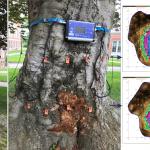 Report by Nick Brazee, Plant Pathologist, UMass Extension Plant Diagnostic Lab, UMass Amherst.
Report by Nick Brazee, Plant Pathologist, UMass Extension Plant Diagnostic Lab, UMass Amherst.
Insects
Noteworthy Sighting:
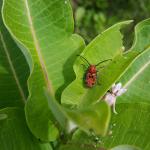 Red Milkweed Beetle: (Tetraopes tetrophthalmus) For those of you growing milkweed for the monarchs, you may find from time to time that other visitors are present and feeding on your plants. Who are we to say who deserves to feast on milkweed and who does not? If you are an insect and your system can tolerate feeding on a plant full of toxins - cardiac glycosides which are concentrated in the milkweed’s sap – I would say you have earned the right to feed on this plant. In fact, the red milkweed beetles sequester these toxins in their bodies, employing a well-known chemical defense strategy, which is also practiced by monarch butterflies, milkweed tussock moths, and certain true bugs that feast on the plant. As with the red milkweed beetle, bright colors are often a warning sign for would-be predators that say “Hey, I’m poisonous…or at least distasteful”. This beetle is member of the same family as Asian longhorned beetle (the Cerambycidae, or long horned beetles). Adults spend most of their time on milkweed, where they can be found resting, feeding, and mating. Adults can feed on all above ground plant parts. Eggs are typically laid near the root crown. Eggs hatch and larval development occurs in the roots of the plant.
Red Milkweed Beetle: (Tetraopes tetrophthalmus) For those of you growing milkweed for the monarchs, you may find from time to time that other visitors are present and feeding on your plants. Who are we to say who deserves to feast on milkweed and who does not? If you are an insect and your system can tolerate feeding on a plant full of toxins - cardiac glycosides which are concentrated in the milkweed’s sap – I would say you have earned the right to feed on this plant. In fact, the red milkweed beetles sequester these toxins in their bodies, employing a well-known chemical defense strategy, which is also practiced by monarch butterflies, milkweed tussock moths, and certain true bugs that feast on the plant. As with the red milkweed beetle, bright colors are often a warning sign for would-be predators that say “Hey, I’m poisonous…or at least distasteful”. This beetle is member of the same family as Asian longhorned beetle (the Cerambycidae, or long horned beetles). Adults spend most of their time on milkweed, where they can be found resting, feeding, and mating. Adults can feed on all above ground plant parts. Eggs are typically laid near the root crown. Eggs hatch and larval development occurs in the roots of the plant.
Woody ornamental insect and non-insect arthropod pests to consider, a selected few:
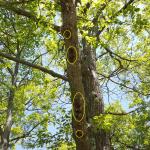
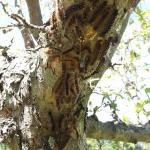
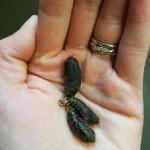
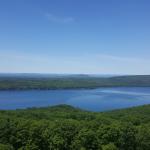 Gypsy Moth:(Lymantria dispar) host plants include but are certainly not limited to oak (favored), maple, birch, poplar, and many others. Gypsy moth caterpillars have begun to pupate at various locations across the state. Caterpillars that have not yet begun this process are in the 5th (males) and 6th (females) instars. As the caterpillars prepare to and complete pupation, they will stop feeding – so the great news is, if you are in a location in MA where defoliation has occurred this year, gypsy moth feeding is done (or nearly done) for the season! Pupation was reported in Amherst, MA beginning the week of 6/22/18. Pupation was also reported in Natick, MA on 6/22/18. Pupae were seen in Belchertown, MA on 6/26/18. At the location in Belchertown, MA the caterpillars that were not yet pupating had begun to gather on branch undersides in large groups, perhaps readying themselves to pupate together. For activity in areas closer to you, please see the Regional Reports above.
Gypsy Moth:(Lymantria dispar) host plants include but are certainly not limited to oak (favored), maple, birch, poplar, and many others. Gypsy moth caterpillars have begun to pupate at various locations across the state. Caterpillars that have not yet begun this process are in the 5th (males) and 6th (females) instars. As the caterpillars prepare to and complete pupation, they will stop feeding – so the great news is, if you are in a location in MA where defoliation has occurred this year, gypsy moth feeding is done (or nearly done) for the season! Pupation was reported in Amherst, MA beginning the week of 6/22/18. Pupation was also reported in Natick, MA on 6/22/18. Pupae were seen in Belchertown, MA on 6/26/18. At the location in Belchertown, MA the caterpillars that were not yet pupating had begun to gather on branch undersides in large groups, perhaps readying themselves to pupate together. For activity in areas closer to you, please see the Regional Reports above.
When visiting a location in Belchertown, MA on 6/26/18 on the shores of the Quabbin Reservoir, it was easy to see that areas visited at this time of the year in 2017 look significantly better than what was seen last year. Entire hillsides that were completely defoliated at this location in 2017 thankfully had leaves present.
On 6/21/18, upon driving eastbound on the MA Turnpike, completely and nearly completely defoliated trees could be seen in patches starting just before the Worcester, MA exits and lasting through Worcester and beyond to just before exit 11A. There was no defoliation on 6/21/18 that could be seen on the MA Turnpike in certain areas that had been observed at this time last year when they were completely defoliated. Therefore, while it might seem for some people that gypsy moth is just as bad if not worse than it was in 2017 (and this could be true locally in small patches), it seems this is limited to patchy areas in certain areas of the state. In general, the defoliation in 2018 should be much less than it was in 2017. However, that is some contest: we had over 923,000 acres of defoliation last year.
One worrisome note for the Amherst and Belchertown areas is that a majority of the gypsy moth caterpillars, as of 6/26/18, look healthy and ready to pupate and survive to adulthood at two locations observed in those towns. Compared to last year, it anecdotally seems that fewer caterpillars have died from the fungus (Entomophaga maimaiga) in 2018. Some mortality from what is suspected to be the virus was also seen on 6/26/18 in these locations. Time will tell; in the next few weeks, adult moths will emerge, mate, and the females will lay the egg masses that will overwinter and provide us with a population for 2019. We can hope that the gypsy moth population size will continue to trend downward, but in certain locations in MA, noticeable populations could still exist in 2019. In the coming weeks, it will be important to monitor the adult females and get a sense of how many total egg masses are being laid in your area, or on individual properties, to aid in management decisions for next season.
- Asian Longhorned Beetle: (Anoplophora glabripennis, ALB) Look for signs of an ALB infestation which include perfectly round exit holes (about the size of a dime), shallow oval or round scars in the bark where a female has chewed an egg site, or sawdust-like frass (excrement) on the ground nearby host trees or caught in between branches. Be advised that other, native insects may create perfectly round exit holes or sawdust-like frass, which can be confused with signs of ALB activity. Adult insects may be seen beginning in July in the regulated area in Massachusetts.
The regulated area for Asian longhorned beetle is 110 miles2 encompassing Worcester, Shrewsbury, Boylston, West Boylston, and parts of Holden and Auburn. If you believe you have seen damage caused by this insect, such as exit holes or egg sites on susceptible host trees like maple, or believe you have captured or taken a photo of an adult insect, please call the Asian Longhorned Beetle Eradication Program office in Worcester, MA at 508-852-8090 or toll free at 1-866-702-9938.
To report an Asian longhorned beetle find online or compare it to common insect look-alikes, visit: http://massnrc.org/pests/albreport.aspx or https://www.aphis.usda.gov/pests-diseases/alb/report .
- Deer Tick/Blacklegged Tick: Ixodes scapularis adult females, following a blood meal, can lay a single egg mass (up to 1500 – 2000 eggs) in mid-late May, and then the female deer tick perishes. Larvae emerge from the eggs later in the summer. Larvae are tiny and six-legged. Prior to feeding, they are not known to be able to transmit disease. After feeding, the larvae drop from their host and molt, re-emerging the following spring as nymphs. Nymphs (from last year’s overwintering cohort) are active from May-August. Nymphs are eight-legged and about the size of the head of a pin. These tiny nymphs typically attach to small mammal hosts; however, they will readily feed on people and pets. Nymphs are capable of carrying Lyme disease, human Babesiosis, human Anaplasmosis, and deer tick virus. For images of all deer tick life stages, along with an outline of the diseases they carry, visit: http://www.tickencounter.org/tick_identification/deer_tick .
Anyone working in the yard and garden should be aware that there is the potential to encounter deer ticks. Preventative activities, such as daily tick checks, wearing appropriate clothing, and permethrin treatments for clothing (according to label instructions) can aid in reducing the risk that a tick will become attached to your body. If a tick cannot attach and feed, it will not transmit disease. For more information about personal protective measures, visit: http://www.tickencounter.org/prevention/protect_yourself .
Have you just removed an attached tick from yourself or a loved one with a pair of tweezers? If so, consider sending the tick to the UMass Laboratory of Medical Zoology to be tested for disease causing pathogens. To submit a tick to be tested, visit: https://www.tickreport.com/ and click on the red “Test A Tick” button. Results are typically available within 3 business days, or less. By the time you make an appointment with your physician following the tick attachment, you may have the results back from TickReport to bring to your physician to aid in a conversation about risk.
The UMass Laboratory of Medical Zoology does not give medical advice, nor are the results of their tests diagnostic of human disease. Transmission of a pathogen from the tick to you is dependent upon how long the tick had been feeding, and each pathogen has its own transmission time. TickReport is an excellent measure of exposure risk for the tick (or ticks) that you send in to be tested. Feel free to print out and share your TickReport with your healthcare provider.
You can also follow TickReport on Twitter @TickReport for timely updates from the Laboratory of Medical Zoology, including the latest tick and tick-borne disease related research.
- Dogwood Spittlebug: (Clastoptera proteus) occurs in New England wherever dogwoods are grown. This species may also feed on Vaccinium and Aesculus. Adults and nymphs of this hemipteran are found feeding on the same host. The adult insect is called a froghopper. Eggs are laid in punctures created by adults in the bark of outer twigs. Each puncture may contain 1-3 eggs. Eggs overwinter and nymphs emerge in June and early July. A sugary, frothy substance is created by the feeding nymphs, as they secrete excess sap as they feed, causing it to froth by pumping air into this excrement. They can be completely hidden in this “spittle”. Dogwood spittlebug activity was seen in Amherst, MA on 6/20/2018. The impact these insects have is largely aesthetic and management is rarely recommended.
- Elongate Hemlock Scale: Fiorinia externa is found on eastern, Carolina, and Japanese hemlock, as well as yew, spruce, and fir. Crawlers will be present this month and throughout the growing season and the overlap of many developmental stages at any given time can be observed. Treatments (active ingredients effective through contact) for the crawler, or mobile, stage of this insect may be made in late May through mid-June, or between 360-700 GDD’s, base 50°F. (Systemic options can be made at other times, such as the spring and fall.)
- Emerald Ash Borer: (Agrilus planipennis, EAB) was recently detected in a new community in Hampden County, MA and confirmed by the MA Department of Conservation and Recreation. This wood-boring beetle readily attacks ash (Fraxinus spp.) including white, green, and black ash, has also been found developing in white fringe tree (Chionanthus virginicus) and most recently, has been reported in cultivated olive (Olea europaea). Signs of an EAB infested tree may include D-shaped exit holes in the bark (from adult emergence), “blonding” or lighter coloration of the ash bark from woodpecker feeding (chipping away of the bark as they search for larvae beneath), and serpentine galleries visible through splits in the bark, from larval feeding beneath. Positive identification of an EAB-infested tree may not be possible with these signs individually on their own.
For further information about this insect, please visit: https://ag.umass.edu/fact-sheets/emerald-ash-borer . If you believe you have located EAB-infested ash trees, particularly in an area of Massachusetts not identified on the map provided, please report here: http://massnrc.org/pests/pestreports.htm .
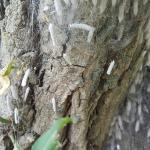 Euonymus Caterpillar: Yponomeuta cagnagella is of European origin and widespread in distribution throughout Europe. It was first reported in North America in Ontario in 1967. On 6/11/2018, a common spindle tree (Euonymus europaeus) on the UMass Amherst campus was found with a heavy infestation of euonymus caterpillars. The infested tree is approximately 3.1 miles away from the initial area in Amherst, MA reported on for this insect. On 6/11/18 in this location, the majority of caterpillars were found to be spinning white cocoons within which they pupate. Large sections of this individual tree are covered in webbing and cocoons. Webbing falling from the tree covers the turf below, and some caterpillars are pupating in clumps of webbed turf. By 6/20/2018, all of the caterpillars at this location have pupated and are present in their white cocoons. A tiny percentage of the small adult moths have emerged as of 6/20/18 at this location. Moths are white with black spots. The euonymus caterpillars (larvae) feed in groups and envelop the foliage of the host plant in webs as they feed. Hosts include: Euonymus europaeus (tree form), E. kiautschovicus, E. alatus, and E. japonicus. Mature caterpillars are just under an inch in length, creamy yellow-gray in color with black spots and a black head capsule. By late June, these larvae pupate in white, oval-shaped cocoons which are typically oriented together vertically either on host plants or non-hosts in the area. Cocoons can be found in cracks and crevices, or webbed together leaves. The adult moth emerges in late June in most locations. The adult female secretes a gummy substance over her eggs which will harden, making them even more difficult to see. Eggs hatch by mid-August, at which time the tiny larvae prepare to overwinter beneath their eggshell-like covering. These larvae are inactive until the following year, when caterpillars group together to feed on newly emerging leaves, creating a mess of webs as they feed. There is one generation per year. Plants may be partially or entirely defoliated.
Euonymus Caterpillar: Yponomeuta cagnagella is of European origin and widespread in distribution throughout Europe. It was first reported in North America in Ontario in 1967. On 6/11/2018, a common spindle tree (Euonymus europaeus) on the UMass Amherst campus was found with a heavy infestation of euonymus caterpillars. The infested tree is approximately 3.1 miles away from the initial area in Amherst, MA reported on for this insect. On 6/11/18 in this location, the majority of caterpillars were found to be spinning white cocoons within which they pupate. Large sections of this individual tree are covered in webbing and cocoons. Webbing falling from the tree covers the turf below, and some caterpillars are pupating in clumps of webbed turf. By 6/20/2018, all of the caterpillars at this location have pupated and are present in their white cocoons. A tiny percentage of the small adult moths have emerged as of 6/20/18 at this location. Moths are white with black spots. The euonymus caterpillars (larvae) feed in groups and envelop the foliage of the host plant in webs as they feed. Hosts include: Euonymus europaeus (tree form), E. kiautschovicus, E. alatus, and E. japonicus. Mature caterpillars are just under an inch in length, creamy yellow-gray in color with black spots and a black head capsule. By late June, these larvae pupate in white, oval-shaped cocoons which are typically oriented together vertically either on host plants or non-hosts in the area. Cocoons can be found in cracks and crevices, or webbed together leaves. The adult moth emerges in late June in most locations. The adult female secretes a gummy substance over her eggs which will harden, making them even more difficult to see. Eggs hatch by mid-August, at which time the tiny larvae prepare to overwinter beneath their eggshell-like covering. These larvae are inactive until the following year, when caterpillars group together to feed on newly emerging leaves, creating a mess of webs as they feed. There is one generation per year. Plants may be partially or entirely defoliated.- European Elm Scale: Gossyparia spuria is a type of felt scale and was observed on an elm on 6/13/17 in Amherst, MA. This particular tree held populations of this insect in 2017 as well. First noted in New York in 1884, this non-native scale is now widespread in North America and is found on native and European elms, but also rarely on hackberry and Zelkova. This insect can cause yellowing of foliage, premature leaf drop, and eventually dieback on its host. Honeydew and thus sooty mold are produced. The females observed in Amherst have produced a ring of white fibers around their black, oval bodies. By the end of June, these females will lay eggs that hatch into bright yellow crawlers, which will disperse to the midrib and leaf veins on the underside of elm leaves where they will remain to feed. Crawlers are tiny and magnification is necessary to observe. Natural enemies such as parasitic wasps and predatory insects have been reported as successful in managing this insect.
- Fall Webworm: Hyphantria cunea is native to North America and Mexico. It is now considered a world-wide pest, as it has spread throughout much of Europe and Asia. (For example, it was introduced accidentally into Hungary from North America in the 1940’s.) Hosts include nearly all shade, fruit, and ornamental trees except conifers. In the USA, at least 88 species of trees are hosts for these insects, while in Europe at least 230 species are impacted. In the past history of this pest, it was once thought that the fall webworm was a two-species complex. It is now thought that H. cunea has two color morphs – one black headed and one red headed. These two color forms differ not only in the coloration of the caterpillars and the adults, but also in their behaviors. Caterpillars may go through at least 11 molts, each stage occurring within a silken web they produce over the host. When alarmed, all caterpillars in the group will move in unison in jerking motions that may be a mechanism for self-defense. Depending upon the location and climate, 1-4 generations of fall webworm can occur per year. Fall webworm adult moths lay eggs on the underside of the leaves of host plants in the spring. These eggs hatch in late June or July depending on climate. Fall webworm caterpillars were reported for 2018 in the Pioneer Valley Region report above. Young larvae feed together in groups on the undersides of leaves, first skeletonizing the leaf and then enveloping other leaves and eventually entire branches within their webs. Webs are typically found on the terminal ends of branches. All caterpillar activity occurs within this tent, which becomes filled with leaf fragments, cast skins, and frass. Fully grown larvae then wander from the webs and pupate in protected areas such as the leaf litter where they will remain for the winter. Adult fall webworm moths emerge the following spring/early summer to start the cycle over again. 50+ species of parasites and 36+ species of predators are known to attack fall webworm in North America. Fall webworms typically do not cause extensive damage to their hosts. Nests may be an aesthetic issue for some. If in reach, small fall webworm webs may be pruned out of trees and shrubs and destroyed. Do not set fire to H. cunea webs when they are still attached to the host plant.
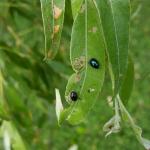 Imported Willow Leaf Beetle: Plagiodera versicolora overwintered adults are present and continue to be active and found on willow foliage. Adult beetles will chew holes and notches in the leaves of willow. Egg laying was observed on 5/16/18, 5/23/18, and 5/30/2018 in Chesterfield, MA.Females lay yellow eggs in clusters on the undersides of leaves. As of 5/30/2018, eggs have hatched at the location in Chesterfield, MA and multitudes of small imported willow leaf beetle larvae are feeding in groups.By 6/13/2018, these larvae have grown larger in size and have skeletonized many leaves.Larvae are slug-like and bluish-green in color. They feed in clusters. By 6/27/18, larvae have pupated at this location in Chesterfield, MA and adults are again present. Most plants can tolerate the feeding from this insect, and foliage will appear brown. Repeated yearly feeding can be an issue, in which case management of the young larvae may be necessary. Take care with treatment in areas near water.
Imported Willow Leaf Beetle: Plagiodera versicolora overwintered adults are present and continue to be active and found on willow foliage. Adult beetles will chew holes and notches in the leaves of willow. Egg laying was observed on 5/16/18, 5/23/18, and 5/30/2018 in Chesterfield, MA.Females lay yellow eggs in clusters on the undersides of leaves. As of 5/30/2018, eggs have hatched at the location in Chesterfield, MA and multitudes of small imported willow leaf beetle larvae are feeding in groups.By 6/13/2018, these larvae have grown larger in size and have skeletonized many leaves.Larvae are slug-like and bluish-green in color. They feed in clusters. By 6/27/18, larvae have pupated at this location in Chesterfield, MA and adults are again present. Most plants can tolerate the feeding from this insect, and foliage will appear brown. Repeated yearly feeding can be an issue, in which case management of the young larvae may be necessary. Take care with treatment in areas near water.- Lace Bugs: Corythucha spp. and Stephanitis spp. lace bugs are active. Corythucha spp. utilize many hosts such as: hawthorn, cotoneaster, Amelanchier, quince, Pyracantha, various oaks, birch, maple, mountain ash, sycamore, hackberry, elm, walnut, butternut, basswood, etc. Corythucha spp. adult lace bugs were seen feeding on bur oak on 6/13/2018 in Amherst, MA. Many adult lace bugs were seen on leaf undersides, along with groups of tiny, black eggs. These groups of lace bug eggs were seen on nearly every leaf examined within reach on this tree. Egg are so small, they may look likefungal spores without magnification.
- Stephanitis spp. lace bugs are active and damage is becoming more apparent. Yellow stippling on leaf surfaces, black colored tar-like spots on leaf undersides, and lace bug nymphs (immatures) were seen on leaf undersides on 5/30/18, 6/7/18, and 6/13/18 in Amherst, MA on Rhododendron spp. foliage. Stephanitis spp. lacebugs such as S. pyriodes can cause severe injury to azalea foliage. S. rhododendri can be common on Rhododendron and mountain laurel. S. takeyai has been found developing on Japanese Andromeda, Leucothoe, Styrax, and willow. Stephanitis spp. lace bug activity should be monitored through September. Before populations become too large, treat with a summer rate horticultural oil spray as needed. Be sure to target the undersides of the foliage in order to get proper coverage of the insects. Fall or early spring soil treatment with imidacloprid has been effective, but be aware of the implications this may have on pollinators attracted to these flowering plants when making management decisions. Certain azalea and Andromeda cultivars may be less preferred by lace bugs.
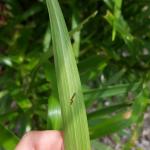
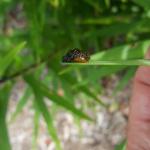 Lily Leaf Beetle: (Lilioceris lilii) Susceptible hosts include Lilium spp. (Turk’s cap, tiger, Easter, Asiatic, and Oriental lilies) and Fritillaria spp. (Note: daylilies are not hosts.) Typically, in May, mating will occur and each female will begin to lay 250-450 eggs in neat rows on the underside of the foliage. In Amherst, MA, orange lily leaf beetle eggs were observed on the underside of host plant foliage on 5/16/2018 and some of these eggs hatched by 5/23/18. Frass-covered larvae were observed feeding on 5/23/18, 5/30/18, 6/7/18, 6/13/18, and 6/27/18 in Amherst, MA. Larvae are growing ever larger and eating entire leaves. Younger groups of eggs are hatching with still tiny larvae starting to feed by skeletonizing the leaf in groups. Where adults and larvae are seen, they can be removed from host plants with a gloved hand, where practical.
Lily Leaf Beetle: (Lilioceris lilii) Susceptible hosts include Lilium spp. (Turk’s cap, tiger, Easter, Asiatic, and Oriental lilies) and Fritillaria spp. (Note: daylilies are not hosts.) Typically, in May, mating will occur and each female will begin to lay 250-450 eggs in neat rows on the underside of the foliage. In Amherst, MA, orange lily leaf beetle eggs were observed on the underside of host plant foliage on 5/16/2018 and some of these eggs hatched by 5/23/18. Frass-covered larvae were observed feeding on 5/23/18, 5/30/18, 6/7/18, 6/13/18, and 6/27/18 in Amherst, MA. Larvae are growing ever larger and eating entire leaves. Younger groups of eggs are hatching with still tiny larvae starting to feed by skeletonizing the leaf in groups. Where adults and larvae are seen, they can be removed from host plants with a gloved hand, where practical.
- Spotted Lanternfly: (Lycorma delicatula, SLF) is not known to occur in Massachusetts. This insect is a member of the Order Hemiptera (true bugs, cicadas, hoppers, aphids, and others) and the Family Fulgoridae, also known as planthoppers. This insect is a non-native species first detected in the United States in Berks County, Pennsylvania and confirmed on September 22, 2014. Until November 2017, this invasive insect was only known to Pennsylvania. It has now been reported from Delaware (November 20, 2017), New York (November 29, 2017), and most recently in Virginia (January 10, 2018). The Delaware Department of Agriculture announced the finding of a single female spotted lanternfly in New Castle County in the Wilmington, Delaware area. At this time, officials in Delaware note that it is unclear if this individual was an accidental hitchhiker, or evidence of an established population in the state. For more information about the find in Delaware, visit: https://news.delaware.gov/2017/11/20/spotted-lanternfly-confirmed-delaware/ . The New York State Department of Agriculture and Markets reported on November 29, 2017 the finding of a single dead individual spotted lanternfly in the state from earlier in the month. A single dead specimen was confirmed at a facility in Delaware County, New York, which is located south-west of Albany. The NYS Dept. of Agriculture and Markets states that this dead individual may have come in on an interstate shipment. For more information about the find in New York, visit: https://www.agriculture.ny.gov/AD/release.asp?ReleaseID=3637 . Most recently, Virginia Cooperative Extension announced the finding of a spotted lanternfly population in Frederick County, Virginia, on January 10, 2018. It was noted that at the location in Virginia, numerous adult lanternflies and egg masses were discovered, in addition to more at another site approximately 400 yards away. For more information about the find in Virginia, visit: https://ext.vt.edu/agriculture/commercial-horticulture/spotted-lanternfly.html .
The spotted lanternfly is considered native to China, India, and Vietnam. It has been introduced as a non-native insect to South Korea and Japan, prior to its detection in the United States. In South Korea, it is considered invasive and a pest of grapes and peaches. The spotted lanternfly has been reported from over 70 species of plants, including the following: tree of heaven (Ailanthus altissima) (preferred host), apple (Malus spp.), plum, cherry, peach, apricot (Prunus spp.), grape (Vitis spp.), pine (Pinus spp.), pignut hickory (Carya glabra), sassafras (Sassafras albidum), serviceberry (Amelanchier spp.), slippery elm (Ulmus rubra), tulip poplar (Liriodendron tulipifera), white ash (Fraxinus americana), willow (Salix spp.), American beech (Fagus grandifolia), American linden (Tilia americana), American sycamore (Platanus occidentalis), big-toothed aspen (Populus grandidentata), black birch (Betula lenta), black cherry (Prunus serotina), black gum (Nyssa sylvatica), black walnut (Juglans nigra), dogwood (Cornus spp.), Japanese snowbell (Styrax japonicus), maple (Acer spp.), oak (Quercus spp.), and paper birch (Betula papyrifera).
The adults and immatures of this species damage host plants by feeding on sap from stems, leaves, and the trunks of trees. In the springtime in Pennsylvania (late April - mid-May) nymphs (immatures) are found on smaller plants and vines and new growth of trees and shrubs. Third and fourth instar nymphs migrate to the tree of heaven and are observed feeding on trunks and branches. Trees may be found with sap weeping from the wounds caused by the insect’s feeding. The sugary secretions (excrement) created by this insect may coat the host plant, later leading to the growth of sooty mold. Insects such as wasps, hornets, bees, and ants may also be attracted to the sugary waste created by the lanternflies, or sap weeping from open wounds in the host plant. Host plants have been described as giving off a fermented odor when this insect is present.
Adults are present by the middle of July in Pennsylvania and begin laying eggs by late September and continue laying eggs through late November and even early December in that state. Adults may be found on the trunks of trees such as the tree of heaven or other host plants growing in close proximity to them. Egg masses of this insect are gray in color and look similar to gypsy moth egg masses.
Host plants, bricks, stone, lawn furniture, recreational vehicles, and other smooth surfaces can be inspected for egg masses. Egg masses laid on outdoor residential items such as those listed above may pose the greatest threat for spreading this insect via human aided movement. For more information about the spotted lanternfly, visit this fact sheet: https://ag.umass.edu/landscape/fact-sheets/spotted-lanternfly .
 Taxus Mealybug: Dysmicoccus wistariae was spotted on taxus in Amherst on 5/23/18, 5/30/18, 6/7/18, 6/13/18, and again on 6/27/18. This insect will produce honeydew which leads to sooty mold growth, yellowing of needles, and sparsely foliated plants. Eventual dieback may be possible. This species is commonly associated with Taxus in New England, but can be occasionally found on dogwood, Rhododendron, Prunus spp., maple, Andromeda, and crabapple. These mealybugs are found on stems and branches and particularly like to congregate at branch crotches. Management may be targeted between 246-618 GDD’s. Horticultural oil and neem oil may be used.
Taxus Mealybug: Dysmicoccus wistariae was spotted on taxus in Amherst on 5/23/18, 5/30/18, 6/7/18, 6/13/18, and again on 6/27/18. This insect will produce honeydew which leads to sooty mold growth, yellowing of needles, and sparsely foliated plants. Eventual dieback may be possible. This species is commonly associated with Taxus in New England, but can be occasionally found on dogwood, Rhododendron, Prunus spp., maple, Andromeda, and crabapple. These mealybugs are found on stems and branches and particularly like to congregate at branch crotches. Management may be targeted between 246-618 GDD’s. Horticultural oil and neem oil may be used.
- Twolined Chestnut Borer: Agrilus bilineatus is a native jewel beetle (also known as a flatheaded borer) in the Family Buprestidae. This insect is also in the same genus as the invasive emerald ash borer. The twolined chestnut borer is native to Massachusetts, much of New England, and the eastern United States. This species has one generation per year and adults are typically active from April – August, depending upon location and temperature. Adults will conduct some maturation feeding on oak prior to mating. Females will lay clusters of tiny eggs in the cracks and crevices of bark. Larvae hatch from the eggs in 1-2 weeks and burrow through the bark into the cambium, where they feed in a similar manner to the emerald ash borer, creating meandering galleries as they feed. (The galleries of the twolined chestnut borer can be straight in very stressed trees.) Larvae typically mature by August – October and burrow to the outer bark where they create a chamber in which they overwinter. Pupation occurs the following spring and adults emerge through D-shaped exit holes that are approximately 1/5 inch wide. In the northern extent of this insect’s range, they can take 2 years to complete their life cycle. Larvae of this insect have been recorded from eastern white oak, common post oak, burr oak, scarlet oak, northern red oak, and eastern black oak. Adults have been recorded on fir and pin oak. In the case of an individual adult twolined chestnut borer observed on 6/7/18 in Amherst, MA, it was lingering on an elm leaf. There are oaks nearby, so this could just be happenstance as the insect searches for a suitable host.These insects are attracted to stressed host plants and typically become a secondary factor in the decline of the tree.
- Viburnum Leaf Beetle: Pyrrhalta viburni is a beetle in the family Chrysomelidae that is native to Europe, but was found in Massachusetts in 2004. Viburnum leaf beetle egg hatch was observed in Boston, MA on 5/4/2018. By early to mid-June, Viburnum leaf beetle larvae will crawl down the host plant, enter the soil surface, and pupate. This typically occurs when the larvae are just under ½ inch in length. After pupation, by early July, adult beetleswill emerge from the soil and begin feeding on Viburnum foliageagain prior to mating and laying eggs. This beetle feeds exclusively on many different species of Viburnum, which includes but is not limited to susceptible plants such as V. dentatum, V. nudum, V. opulus, V. propinquum, and V. rafinesquianum. Larvae, where they are present, may be treated with a product containing spinosad. Some Viburnum have been observed to have varying levels of resistance to this insect, including but not limited to V. bodnantense, V. carlesii, V. davidii, V. plicatum, V. rhytidophyllum, V. setigerum, and V. sieboldii. More information about Viburnum leaf beetle may be found at http://www.hort.cornell.edu/vlb/ .
- White Spotted Pine Sawyer (WSPS): Monochamus scutellatus adults can emerge from late May through July, depending on local temperatures. The first report of a white spotted pine sawyer adult came from the Asian Longhorned Beetle Eradication Program in Worcester, MA. A concerned citizen in Hampshire County, MA reported (with a photo) a white spotted pine sawyer adult on 5/22/2018. A second report of 3 white spotted pine sawyers came to UMass Extension from a concerned citizen in Hampden County, MA on 6/8/2018. The report was given with photos that clearly allowed for the insect to be identified. This report was shared with the ALB Eradication Program. This is a native insect in Massachusetts and is usually not a pest. Larvae develop in weakened or recently dead conifers, particularly eastern white pine (Pinus strobus). However, the adult white spotted pine sawyer looks very similar to the invasive Asian Longhorned Beetle, Anoplophora glabripennis, ALB. ALB adults do not typically emerge in Massachusetts until July and August. Beginning in July, look for the key difference between WSPS and ALB adults, which is a white spot in the top center of the wing covers (the scutellum) on the back of the beetle. White spotted pine sawyer will have this white spot, whereas Asian longhorned beetle will not. Both insects can have other white spots on the rest of their wing covers; however, the difference in the color of the scutellum is a key characteristic. See the Asian longhorned beetle entry above for more information about that non-native insect. (And where to go to report anything suspicious.)
Concerned that you may have found an invasive insect or suspicious damage caused by one? Need to report a pest sighting? If so, please visit the Massachusetts Introduced Pests Outreach Project: http://massnrc.org/pests/pestreports.htm .
A note about Tick Awareness: deer ticks (Ixodes scapularis), the American dog tick (Dermacentor variabilis), and the lone star tick (Amblyomma americanum) are all found throughout Massachusetts. Each can carry their own complement of diseases. Anyone working in tick habitats (wood-line areas, forested areas, and landscaped areas with ground cover) should check themselves regularly for ticks while practicing preventative measures. Have a tick and need it tested? Visit the web page of the UMass Laboratory of Medical Zoology (https://www.tickreport.com/ ) and click on the red Test a Tick button for more information.
Reported by Tawny Simisky, Extension Entomologist, UMass Extension Landscape, Nursery, & Urban Forestry Program
Plant of the Week
Here is an eye-catching plant to try in your landscape, moving in the breeze and providing shelter for over-wintering beneficial insects including pollinators. This Pennisetum is not considered invasive but be careful in your selection because there are four species of Pennisetum that are on the MA Prohibited Plants List.
Bridgit Litchfield reporting for Mandy Bayer
[/]
Additional Resources
To receive immediate notification when the next Landscape Message update is posted, be sure to join our e-mail list and follow us on Facebook and Twitter.
For a complete listing of upcoming events, see our Upcoming Educational Events page.
For commercial growers of greenhouse crops and flowers - Check out UMass Extension's Greenhouse Update website
For professional turf managers - Check out Turf Management Updates
For home gardeners and garden retailers - Check out home lawn and garden resources. UMass Extension also has a Twitter feed that provides timely, daily gardening tips, sunrise and sunset times to home gardeners, see https://twitter.com/UMassGardenClip
Diagnostic Services
A UMass Laboratory Diagnoses Landscape and Turf Problems - The UMass Extension Plant Diagnostic Lab is available to serve commercial landscape contractors, turf managers, arborists, nurseries and other green industry professionals. It provides woody plant and turf disease analysis, woody plant and turf insect identification, turfgrass identification, weed identification, and offers a report of pest management strategies that are research based, economically sound and environmentally appropriate for the situation. Accurate diagnosis for a turf or landscape problem can often eliminate or reduce the need for pesticide use. For sampling procedures, detailed submission instructions and a list of fees, see Plant Diagnostics Laboratory
Soil and Plant Nutrient Testing - The University of Massachusetts Soil and Plant Nutrient Testing Laboratory is located on the campus of The University of Massachusetts at Amherst. Testing services are available to all. The function of the Soil and Plant Nutrient Testing Laboratory is to provide test results and recommendations that lead to the wise and economical use of soils and soil amendments. For complete information, visit the UMass Soil and Plant Nutrient Testing Laboratory web site. Alternatively, call the lab at (413) 545-2311.
Ticks are active at this time! Remember to take appropriate precautions when working and playing outdoors, and conduct daily tick checks. UMass tests ticks for the presence of Lyme disease and other disease pathogens. Learn more
